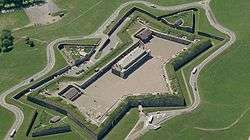40th Regiment of Foot
| 40th Regiment of Foot | |
|---|---|
 Officer's Cap Badge 40th Regiment of Foot Badge c.1830 | |
| Active | 1717–1881 |
| Country |
|
| Branch |
|
| Type | Line Infantry |
| Role | Light Infantry |
| Size | One battalion |
| Nickname(s) | "The Excellers", "The Fighting Fortieth" |
| Colors | Light Buff Facings, Gold Braided Lace |
| March | Quick: Slow: |
| Engagements |
Father Rale's War King George's War Father Le Loutre's War French and Indian War American Revolutionary War Napoleonic Wars |
The 40th Regiment of Foot was an infantry regiment of the British Army, formed in 1717 in Annapolis Royal, Nova Scotia. The regiment amalgamated with the 82nd Regiment of Foot (Prince of Wales's Volunteers) to form the The Prince of Wales's Volunteers (South Lancashire Regiment) in 1881.
Early years

Formation
The regiment was raised at Annapolis Royal in Nova Scotia by General Richard Philipps in August 1717 out of independent companies stationed in North America and the West Indies.[1][2]
Father Rale's War
Prior to Father Rale's War, the Mi'kmaq resisted the establishment of a British fort at Canso, Nova Scotia by raiding the fishing station in 1720. Phillips sent a company of the 40th, under the command Major Lawrence Armstrong, to take up garrison of a small fort in Canso built by the New England fishermen.[3] The Mi'kmaq continued preying on shipping, forcing the garrison to take action in February 1723.[4] Serving as marines, the troops and local fishermen were able to disperse the marauding Indians. The next engagement came in July 1724 when a party of sixty Indians attacked Annapolis Royal. The garrison responded with a poorly calculated sortie from the town's dilapidated fort, resulting in the death of a sergeant and private, the wounding of an officer and three privates, and the repulse of the troops. After some pillaging, the Mi'kmaq departed with a number of civilian prisoners.[5]
From 1717 to 1743, Phillips' Regiment, garrisoning Annapolis, Placentia, and Canso, was successful in protecting settlers from Indian attacks, checking French influence in the area, and preserving the British foothold in Atlantic Canada.[5]
King George's War

At the outbreak of King George's War, the French at Louisbourg immediately engaged in the Raid on Canso in May 1744.[6] A flotilla containing 900 French regulars and militia. The four poorly supplied companies of Phillips' Regiment were forced to surrender. The town was destroyed and the prisoners sent to Louisbourg. Once the regiment's officers and men were paroled in September 1744, the regiment was evacuated to Boston where they provided valuable information on the defences of Louisbourg for the British siege the following year.[5] Governor Shirley was having difficulty raising troops requested by Mascarene and therefore he ordered the ex-Canso garrison to Annapolis Royal.[7]

The Newfoundland Campaign started during August 1744. Captain Robert Young, of the 44-gun ship Kinsale, lying in St. John's, Newfoundland, received intelligence that five French ships were in the port of Fishotte and resolved on despatching an armed prize to attack them. The prize was named the St. Philip, and was manned by eighty men of the Kinsale's crew, and commanded by one of her lieutenants,[8] and accompanied by three 10-gun colonial privateers. The St. Philip succeeded, after grounding several times, in reaching the Moderate, of twelve guns and seventy-five men, which was boarded and carried ; then turning the Moderate's guns against the remaining ships, without the assistance of the privateers (who did not get into the harbour in time), compelled the whole to surrender. The St. Philip had ten killed, and thirty wounded.[9] The loss on board the French ships was more severe. The five vessels, which had on board 18,000 quintals of fish and eighty tons of oil, mounted together sixty-six guns, and carried 342 men.[10]
In July 1744, three hundred Indians under command of a French priest named Le Loutre attacked Annapolis, the only British garrison in Nova Scotia. Only eighty men of Phillips' Regiment were available to meet this threat, commanded by Lieutenant Colonel Paul Mascarene. Mascarene refused to surrender to Le Loutre. Le Loutre's party eventually burned a number of houses and withdrew. Following this, George II authorized the reorganization of the regiment which increased to six regiments the garrison at Annapolis, with an authorized complement of 450. Initially only seventy additional men were received. Recruitment efforts continued and Governor Shirley sent 206 recruits in February 1746. Despite the additional manpower the regiment remained under strength. It was at this time that Captain John Winslow first took command of a Philipp's regiment at Annapolis Royal, after being transferred from Newfoundland.[11] In September the enemy, this time three hundred regulars and militia with Indian support, reappeared outside the dilapidated earthworks of Annapolis Royal. After a four-week siege and lacking a train of artillery, the French withdrew from the defiant garrison.[5]

A force of six hundred French and Indians again attempted to take Annapolis in May 1745. This demonstration ended quickly with the French and Mi'kmaq being ordered back to help defend Louisbourg from the British.[12]
The only other action seen by Phillips' Regiment occurred while serving as marines and seamen. A detachment from the garrison at St. John's, Newfoundland volunteered to serve on a captured twenty-gun ship for an expedition with three privateers to Fishotte Bay. The prize entered Fishotte Bay alone and engaged a number of anchored French ships. After five hours of fighting and the loss of ten killed and thirty wounded, the ship had captured three fourteen-gun and two twelve-gun enemy ships; forty six of their crews were killed and three hundred and thirty two made prisoner. The lagging privateers entered the harbour and assisted in the destruction of French fishing stages and the removal of enemy ships and prisoners.[5]
By the end of the war Phillips' Regiment, after defending Britain's foothold in Nova Scotia with a skeleton complement, had its establishment raised to seventy men for each company. Men were quickly impressed in England for service in the regiment.[5]
Between 1746 and 1748 the regiment contented itself with garrison duty at Annapolis and St. John's. With a continuing problem of finding recruits in Britain for the Philipp's regiment George II took the unusual step of allowing recruitment from the colonies for the British regiment.[13]
Father Le Loutre's War

The 40th was also actively engaged in Father Le Loutre's War. In July 1749, the grenadier company under Captain Handfield were sent to garrison the new settlement of Halifax founded the month earlier by the new Governor of Nova Scotia, Edward Cornwallis. A surprise attack by local Mi'kmaq in the Siege of Grand Pré resulted in the capture of a detachment of the company including Lieutenant Hamilton and Handfield's son.[14] The captives were later returned to Halifax. Further engagements occurred with the Indians that year as the troops preserved the line of communication between Halifax and Annapolis Royal. Additional members of the regiment formed the garrison of Fort Sackville and established themselves at Fort Edward.[5]
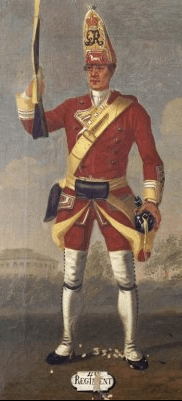
By 1750 Cornwallis had taken over the colonelcy of the regiment. By the Royal Warrant of 1 July 1751, Cornwallis' Regiment was given the numerical distinction of the 40th Regiment of Foot.[15][16] Neglected for so many years by its former colonel, Cornwallis set about enhancing the condition of his new regiment. The companies in Newfoundland were rotated and discipline was improved. Desertion was poorly tolerated by Cornwallis. Of six deserters stationed at Fort Vieux Logis, two were shot and the rest reprieved. Three other deserters were hanged and their bodies suspended in chains as a warning to others. Further changes happened in the 40th with Cornwallis' appointment of Major Charles Lawrence of the 45th to the regiment's lieutenant colonelcy. Lawrence proved to be an energetic and effective military and administrative leader. After his appointment, Lawrence lead an expedition to the Missaguash River in August 1750 where he routed in the Battle at Chignecto a superior number of Indians under Le Loutre. That fall he built Fort Lawrence across the river where the following spring the French would build Fort Beausejour.[5]
In 1752 Peregrine Hopson succeeded Cornwallis as Nova Scotia's governor and colonel of the 40th Regiment. In poor health, Hopson returned to England in 1753 leaving the governing of the colony to Lawrence. In 1755 Hopson officially resigned as governor and Lawrence was appointed. However Hopson remained the colonel of the 40th Regiment until his death in 1759. (Afterward, for the first time since its formation, the regiment's colonel was not the governor of Nova Scotia. Hopson was succeeded as colonel in 1759 by John Barrington, followed by Robert Armiger in December 1760.)[5]
French and Indian War

By 1755 it was decided that the recently erected French Fort Beausejour had to be removed as a threat. The English force, including members of the 40th Regiment, was meet by a large body of regulars and militia as they crossed the Missaquash river. This enemy force was attacked and dispersed quickly. Beausejour was subsequently laid siege to on 21 June and it surrendered four days later.[17]
Also in 1755, under the command of John Handfield, the 40th were engaged in the Expulsion of the Acadians from Annapolis Royal. After such a long stay in the colony, a number of the officers had married into the local Acadian population. Therefore, the deportation order forced officers to exile their own relations. Even the commander of the garrison, Major Handfield, had to deport his wife's "sister-in-law, nephews and nieces, uncles, aunts, and cousins." Handfield wrote to another officer performing the same task: "I heartily join with you in wishing that we were both of us got over this most disagreeable and troublesome part of the Service."[5]
In 1757, after forty years in Annapolis Royal, the town where the regiment had been raised, 43rd relieved the 40th where it then went to Halifax to prepare for service in the Seven Years' War.[18] In 1758, under the command of Lieutenant-Colonel John Handfield, the regiment participated in the second siege of Louisbourg.[19][20] Some companies of the regiment participated in the Louisbourg Grenadiers on its formation in 1759.[21]
The regiment moved to Barbados in December 1761[22] and then took part in the the Battle of Havana in June 1762.[23] In June 1763 the regiment rotated out of Havana to Annapolis Royal where it served until 1767 when it was transferred to Ireland.[24] This would be the first time in its 48-year history that the British regiment would serve on British soil.[19]
American Revolution
The regiment landed in Boston for service in the American Revolutionary War in June 1775.[25] It was evacuated from Boston in March 1776 and went to Halifax from where a detachment was sent to Georgia to gather rice for the army in June 1776.[26] It saw action at the Battle of Long Island in August 1776,[27] the Battle of Fort Washington in November 1776[28] and the Battle of Princeton in January 1777.[29] It was in combat again at the Battle of Brandywine in September 1777[30] and the Battle of Germantown in October 1777.[31] In November 1778 the regiment embarked for Barbados and took part in the Battle of St. Lucia in December 1778.[32] The regiment was then based in Antigua until June 1781 when it returned to Staten Island[33] and then took part in the Battle of Groton Heights in September 1781:[34] Major William Montgomery, commanding the regiment was killed in the assault.[35] In August 1782, the regiment took a county title as the 40th (2nd Somersetshire) Regiment of Foot).[15] The regiment embarked for home in November 1783.[36]
Napoleonic Wars
In January 1794 the regiment embarked for Barbados for service in the French Revolutionary Wars and took part in the capture of Martinique in March 1794[37] and the attack on Guadeloupe in April 1794: some members of the regiment became prisoners of war and were held on the island for over a year.[38] The rest of the regiment returned home and in June 1794 embarked for Ostend:[39] the regiment was not significantly engaged and returned home again in April 1795.[40]
The 40th was part of the force that attempted to capture Buenos Aires in 1806. After two years back in Britain, it was deployed to Spain and Portugal in what would become the Peninsular War, thus being one of only three regiments to serve throughout the entire Peninsula campaign. Briefly sent to Canada in 1814 during the War of 1812 (1812–15) it was soon recalled upon the ending of that conflict.
In 1815 the regiment was rushed to join with Wellington’s army just before the Battle of Waterloo commenced. Initially placed in reserve, they were later in the day moved to the centre of his line to a position near La Haye Sainte. They held firm all day and helped drive off Napoleon's final massed infantry attack, ultimately losing 170 killed or wounded, including their commanding officer Major Arthur Rowley Heyland.[41]
Australasia and India
The 40th (2nd Somersetshire) Regiment of Foot spent a number of years of duty in the Australian colonies. From 1823 to 1829, they were posted to New South Wales, where they served at both Sydney, and Van Diemen's Land.[42]
They were then transferred to Bombay, with the first units of the 40th leaving Australia in 1828.[43] While in India, the 40th was stationed in a number of places within the Bombay Presidency. In 1839 they were sent to the Sindh and took part in the capture of Karachi. The regiment then carried out operations in the Sindh against Nasar Khan. They captured the fort at Kajak in 1841.
They also fought during the First Anglo-Afghan War. The regiment entered Afghanistan in 1841 and camped at Quetta on their way to Afghanistan where they experienced one of the worst out breaks of disease of any regiment of the British army.[43] They fought with General Nott during his campaign in Afghanistan in 1842. They returned to India in December 1842 and fought in the Gwalior Campaign at the Battle of Maharajpore in 1843.
They returned to Australia in 1852 and remained until 1860, serving in Victoria, where they suppressed the Eureka Rebellion of 1854.[42] Detachments from the regiment were also stationed in South Australia and Western Australia.
From 1860 until 1865, the regiment took part in the Taranaki and Waikato campaigns, during the New Zealand Wars.
Uniforms
-
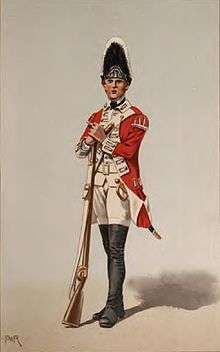
Grenadier, 40th Regiment of Foot, 1767
-

Officer and Private, 40th Regiment of Foot, 1815
-
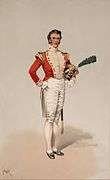
Officer from the Light Company, 40th Regiment of Foot, 1826
-

Drummer, 40th Regiment of Foot, 1848
-
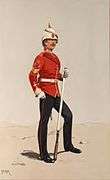
Colour Sergeant, 40th Regiment of Foot, 1881
Battle honours
The battle honours of the regiment were as follows:[15]
- Egypt, Montevideo, Roliça, Vimiero, Talavera, Badajoz, Salamanca, Vittoria, Pyrenees, Nivelle, Orthes, Peninsula, Toulouse, Waterloo, Candahar (1842), Ghuznee (1842), Cabool (1842), Maharajpore, New Zealand
Colonels of the Regiment
Colonels of the regiment were:[15]
- 1717–1750: Lt-Gen. Richard Philipps
- 1750–1752: Lt-Gen. Hon. Edward Cornwallis
The 40th Regiment of Foot
- 1752–1759: Maj-Gen. Peregrine Thomas Hopson
- 1759–1760: Maj-Gen. Hon. John Barrington
- 1760–1770: Lt-Gen. Robert Armiger
- 1770–1786: Lt-Gen. Sir Robert Hamilton, 4th Baronet
The 40th (2nd Somersetshire) Regiment
- 1786–1818: Gen. Sir George Osborn, 4th Baronet
- 1818–1829: Gen. Sir Brent Spencer, GCB
- 1829–1834: Gen. Sir James Kempt, GCB, GCH
- 1834–1837: Lt-Gen. Sir George Cooke, KCB
- 1837–1842: Lt-Gen. Sir Lionel Smith, 1st Baronet, GCB, GCH
- 1842–1861: F.M. Sir Alexander George Woodford, GCB, GCMG
- 1861–1872: Gen. Richard Greaves
- 1872–1881: Gen. Augustus Halifax Ferryman, CB
See also
References
- ↑ Smythies, p. 1
- ↑ Piers, p. 115
- ↑ Dunn, p. 116.
- ↑ Smythies, p. 5
- 1 2 3 4 5 6 7 8 9 10 Henderson, Robert. "His Majesty's 40th Regiment of Foot in North America 1717-1764". The Seven Years War Website. Retrieved 24 August 2013.
- ↑ Smythies, p. 10
- ↑ Dunn, p. 159.
- ↑ Two of the lieutenants of the Kinsale at that time were Thomas Crosse and Charles Cheesemore.
- ↑ Smythies, p. 13
- ↑ Allen, p. 153
- ↑ Dunn, pp. 160–161.
- ↑ Dunn, p. 157.
- ↑ Dunn, p. 170.
- ↑ Smythies, p. 14
- 1 2 3 4 "40th (the 2nd Somersetshire) Regiment of Foot". regiments.org. Archived from the original on 15 September 2006. Retrieved 11 July 2016.
- ↑ Smythies, p. 15
- ↑ Smythies, p. 18
- ↑ Smythies, p. 20
- 1 2 Dunn, p. 216
- ↑ Smythies, p. 21
- ↑ Smythies, p. 26
- ↑ Smythies, p. 32
- ↑ Smythies, p. 33
- ↑ Smythies, p. 36
- ↑ Smythies, p. 40
- ↑ Smythies, p. 41
- ↑ Smythies, p. 42
- ↑ Smythies, p. 45
- ↑ Smythies, p. 47
- ↑ Smythies, p. 49
- ↑ Smythies, p. 50
- ↑ Smythies, p. 56
- ↑ Smythies, p. 57
- ↑ Smythies, p. 58
- ↑ Smythies, p. 59
- ↑ Smythies, p. 60
- ↑ Smythies, p. 65
- ↑ Smythies, p. 66
- ↑ Smythies, p. 67
- ↑ Smythies, p. 70
- ↑ "Major Arthur Rowley Heyland". Friends of the British Cemetery. Retrieved 6 September 2016.
- 1 2 Odgers, p. 17
- 1 2 Raymond Smythies, Cpt. R. H. (1894). Historical Records of the 40th (2nd Somersetshire) Regiment. Devonport: A. H. Swiss.
Sources
- Allen, Joseph (1852). Battles of the British Navy. Henry George Bohn.
- Dunn, Brenda (2004). A History of Port-Royal/Annapolis Royal 1605–1800. Nimbus Publishing and the Historical Association of Annapolis Royal. ISBN 978-1551097404.
- Odgers, George (1988). Army Australia: An Illustrated History. Frenchs Forest, New South Wales: Child & Associates. ISBN 0-86777-061-9.
- Piers, Harry (1927). Regiments Raised in Nova Scotia. Nova Scotia Historical Society.
- Smythies, Captain Raymond R. H. (1894). Historical Records of the 40th (2nd Somersetshire) Regiment. Devonport: A. H. Swiss.
External links
- Queen's Lancashire Regiment Museum
- 40th Regiment – Re-enactors, French and Indian War
- HM 40th Regiment of Foot, Light Infantry Company – A Living history organization portraying the Light Company during the American War for Independence
- Harry Piers, "The Fortieth Regiment, Raised at Annapolis Royal in 1717; And Five Regiments Subsequently Raised in Nova Scotia," Nova Scotia Historical Society (1927)
- Lt.-Col. Otho Hamilton of Olivestob : lieutenant-governor of Plancentia, lieutenant-colonel in the army, major of the 40th Regiment of Foot, member of the Nova Scotia council from 1731 to 1744 ; his sons, captain John and lieutenant-colonel Otho Hamilton, 2nd, and his grandson, Sir Ralph Hamilton, Kt. (1899)
